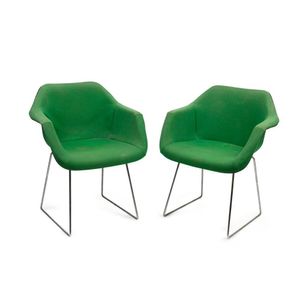
Pair of Robin Day Chairs for Hille, British, circa 1970s
A pair of Robin day chairs for Hille, British, circa 1970s, cherry red wool fabric, plastic and metal, 74 cm high, 47 cm wide, 47 cm deep. Provenance: The John Henry collection, Melbourne

Robin Day Hille Chair, Britain, 1970s, John Henry Collection
A Robin day chair for Hille, Britain, circa 1970s, moulded swivel shell on polished chrome base, 76 cm high, 50 cm wide, 45 cm deep. Provenance: The John Henry collection, Melbourne

Robin Day Chairs for Hille, Britain, 1970s, Cherry Red Wool
A pair of Robin Day chairs for Hille, Britain, circa 1970's, cherry red wool fabric, plastic and metal, 74 cm high, 47 cm wide, 47 cm deep

Retro Easy Chairs with Chrome Skid Bases by Hille-Aristoc Fler
Fler pair of retro easy chairs with chrome skid bases, labelled 'Hille, Made Under License by Aristoc Fler Furniture', 62 cm across the arms

1960s Robin Day coffee table for Hille, ABS plastic England
Robin Day coffee table for Hille, ABS plastic with central compartment, England, c 1960s, 33 cm high, 60 cm deep

Robin Day Mahogany Sideboard with Glass Top and Storage
Robin Day, mahogany and cherry sideboard, English c. 1948, glazed superstructure, slatted shelf beneath, glass topped base with four drawers, two sliding doors enclosing shelves, manufactured by Hille of London. Height 126.5 cm. Depth 43 cm. Width 182 cm.…

Mahogany Serving Table by Robin Day
Robin Day, mahogany and cherry serving table, English c. 1940, glazed superstructure, slatted shelf beneath, manufactured by Hille of London. Height 86 cm. Depth 46 cm. Width 142.5 cm

Robin Day Hille Chairs
Robin Day for Hille international, set of four chairs, each with injection moulded polypropylene seat with bent tubular steel frame

Robin Day Hille Chairs - Set of 4
Robin Day for Hille international, set of four chairs, each with injection moulded polypropylene seat with bent tubular steel frames

Hillestak Chairs by Robin Day, Rare Set of Four
Robin Day. Hillestak chairs, for S Hille & Co, UK 1950. A rare set of four side chairs with beech stacking A frames and molded plywood seat and backs. Original stamped numbers to the base. Provenance: Purchased in Manhattan, New York City 2001
 Loading more...
Loading more...